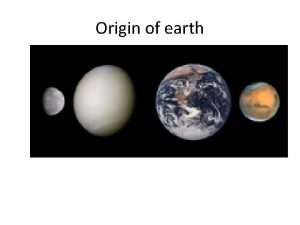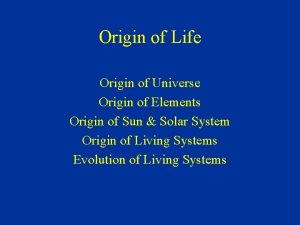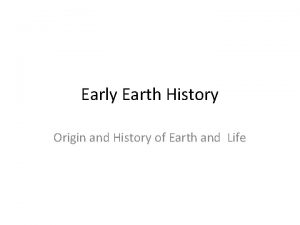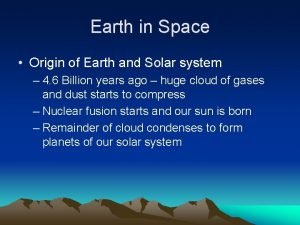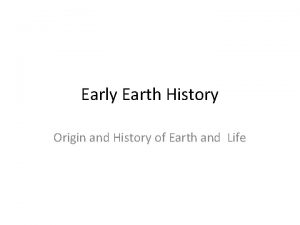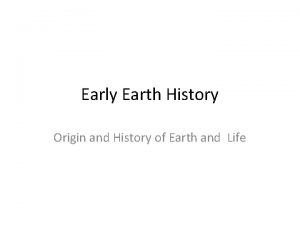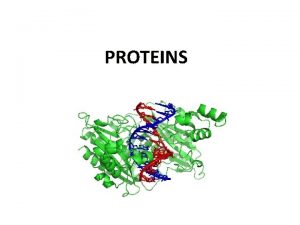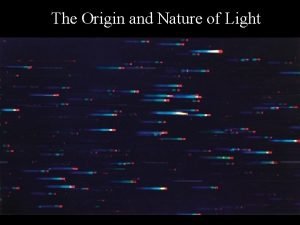Origin of earth Earth is the largest and




















- Slides: 20

Origin of earth

Earth is the largest and densest of the inner planets, the only one known to have current geological activity, and is the only place in the Solar System where life is known to exist. Its liquid hydrosphere is unique among the terrestrial planets, and it is also the only planet where plate tectonics has been observed. Earth's atmosphere is radically different from those of the other planets, having been altered by the presence of life to contain 21% free oxygen. [60] It has one natural satellite, the Moon, the only large satellite of a terrestrial planet in the Solar System.

How our earth came into existence ? ?

Theories of Earth's Origin The planets were spun off of the sun this theory suggests that the planets were spun off of the sun, and are thus essentially daughters of the sun. This requires a near collision with a large body. • the sun would have most of the angular momentum • The sun would be less massive than it is.

The nebular cloud hypothesis suggests that the solar system started out as a nebular cloud and that the planets and sun were concentrated from the dust and gasses in the cloud by gravitational attraction. • cloud would have been 30 -40 light years across • mass of cloud would have been 2 -10 times the present Solar System mass. • originally extremely thin • coalesced by gravity and magnetic attraction • Collision heated sun until it started spontaneous fusion • initial solar wind drove off Earth's light elements, primitive Earth atmosphere--what is left is only 1/1200 of original mass.

Solar nebula and bigbang The most prominent scientific theory about the origin of the Earth involves a spinning cloud of dust called a solar nebula. This nebula is a product of the Big Bang. Philosophers, religious scholars and scientists have lots of ideas about where the universe came from, but the most widely-held scientific theory is the Big Bang Theory. According to this theory, the universe originated in an enormous explosion.


Before the Big Bang, all of the matter and energy now in the universe was contained in a singularity. A singularity is a point with an extremely high temperature and infinite density. This singularity floated in a complete vacuum until it exploded, flinging gas and energy in all directions. Imagine a bomb going off inside an egg -- matter moved in all directions at high speeds.

As the gas from the explosion cooled, various physical forces caused particles to stick together. As they continued to cool, they slowed down and became more organized, eventually growing into stars. This process took about a billion years.

The existence of a universe-initiating explosion is supported by several lines of evidence, • most notably the observed motions of the galaxies, • the observed background electromagnetic hiss generated during the bang, and • evidence from the observed abundance of light chemical elements in the universe.

There's no concrete evidence for exactly how the Earth formed within this nebula. Scientists have two main theories. Both involve accretion, or the sticking together of molecules and particles. They have the same basic idea -about 4. 6 billion years ago, the Earth formed as particles collected within a giant disc of gas orbiting what would become our sun. Once the sun ignited, it blew all of the extra particles away, leaving the solar system as we know it.

Through earthquakes, volcanic eruptions and other factors, the Earth's surface eventually reached the shape that we know today. Its mass provides the gravity that holds everything together and its surface provides a place for us to live. But the whole process would not have started without the sun.

The Heating, Cooling and Coalescing of the Earth • Initial accretion of the Earth was cool • heat originated from collision, radioactive decay. • heavy elements (nickel and Iron) migrated to center to form core by gravity as material became molten; lighter material floated to the top to form crust, and material of intermediate density formed the mantle. • Earth began to cool, but the inside continues to be heated by radioactive decay.

The Oceans Volcanic Origin The idea that the oceans and early second atmosphere are derived from water and gasses originally bound up in earth's rocks Water from Space The idea is that the oceans (and early, second atmosphere) are derived from comets, which are mostly water, which have bombarded the earth especially in during the early formation of the earth.

The Atmosphere and Life The Composition of the Proto Atmosphere • Principle components would have been H 2 O, N 2, CO 2, with small amounts of H 2, and CO it is also probably that there were simple counpounds such as CH 4 and NH 3. • This atmosphere lacked free oxygen, which would have made any organic molecules very stable

Theories of Abiotic Synthesis Aleksandr Oparin (1938) Atmospheric gases and outside energy sources could have formed the earliest organic molecules The Stanley Miller Experiment (1953) made an apparatus to duplicate the early atmosphere with simulated lightening and a boiling water ocean and thereby created organic molecules including nucleic acids. Such molecules might have accumulated without being either oxidized or eaten in the early atmosphere. the next step was polymerization of the molecules. the RNA first hypothesis states that only RNA was needed to begin life and order the polymerization of organic compounds. Some viruses have only RNA for genetic material.

the Protein-first hypothesis was supported by the work of Sidney Fox who demonstrated that proteins can polymerize abiotic ally when exposed to dry heat. When the proteins are returned to water they form microspheres which resemble cells in many ways. the Clay-substrate hypothesis was proposed by Graham Cairns. Smith. This theory suggests that both protein and RNA were formed simultaneously in association with clay particles. From Chemicals to Life -- the first Cells Life is organized into cells wherein the processes of life occur separated from the outside world by a cell membrane. Thus, the trick is getting the chemicals organized. Cell Membrane Fox's microspheres are similar to cell membranes. They show that molecules can self-order into cell-membrane like structures. The next step is to combine the material to a self replicating unit.

Heterotrophs and Autotrophs • The first organisms were probably heterotrophs, consuming materials around them, and they were anaerobic because there was no free oxygen available. • Fermentation may be the earliest way of obtaining energy by heterotrophs. • Photoassimilation was possibly the next step. this is also an anaerobic process • Photosynthesis developed next, photosynthesis produces free oxygen. The Formation of the Modern Atmosphere Photosynthesis is a by product of photosynthesis. The first oxygen produced became bound in the reduced materials in the environment--especially iron.

How Long Did Planet Formation Take? The ages of the Solar System, the planets, and individual rocks on the planets can be determined from the abundances of isotopes of several elements. The basic principle is that a radioactive isotope decays to a stable isotope; the longer the time, the less of the radioactive isotope is present. For example, rubidium-87 decays to strontium-87. In some cases, the radioactive isotope has such a short half life (the time required for the abundance of the isotope to decrease by one half) that it no longer exists. Examples of such short-lived isotopes include aluminum-26 (half life of 700, 000 years) and hafnium-182 (9 million years).

The oldest materials that formed in the Solar System are inclusions rich in calcium and aluminum found within carbonaceous chondrite meteorites. Nicknamed CAIs (for Calcium-Aluminum-rich Inclusions), these objects are thought to have been some of the first solids to form after the cloud of gas and dust began to heat up. CAIs have ages of 4. 566 billion years. On the basis of measurements of several isotopes, the Earth and Moon formed about 50 to 100 million years later.
 Hình ảnh bộ gõ cơ thể búng tay
Hình ảnh bộ gõ cơ thể búng tay Ng-html
Ng-html Bổ thể
Bổ thể Tỉ lệ cơ thể trẻ em
Tỉ lệ cơ thể trẻ em Voi kéo gỗ như thế nào
Voi kéo gỗ như thế nào Tư thế worm breton
Tư thế worm breton Chúa sống lại
Chúa sống lại Các môn thể thao bắt đầu bằng từ đua
Các môn thể thao bắt đầu bằng từ đua Thế nào là hệ số cao nhất
Thế nào là hệ số cao nhất Các châu lục và đại dương trên thế giới
Các châu lục và đại dương trên thế giới Công thức tính độ biến thiên đông lượng
Công thức tính độ biến thiên đông lượng Trời xanh đây là của chúng ta thể thơ
Trời xanh đây là của chúng ta thể thơ Mật thư anh em như thể tay chân
Mật thư anh em như thể tay chân Làm thế nào để 102-1=99
Làm thế nào để 102-1=99 độ dài liên kết
độ dài liên kết Các châu lục và đại dương trên thế giới
Các châu lục và đại dương trên thế giới Thể thơ truyền thống
Thể thơ truyền thống Quá trình desamine hóa có thể tạo ra
Quá trình desamine hóa có thể tạo ra Một số thể thơ truyền thống
Một số thể thơ truyền thống Cái miệng bé xinh thế chỉ nói điều hay thôi
Cái miệng bé xinh thế chỉ nói điều hay thôi Vẽ hình chiếu vuông góc của vật thể sau
Vẽ hình chiếu vuông góc của vật thể sau





















